On this page some avaiable MSc-assignments within the chair of Laser Processing are listed . There are more assignments! If you are interested in doing an assignment in our group, please contact us.
Laser beam shaping to optimize the temperature profile in the laser cladding process through modeling
Background
In the laser cladding process, a stream of powder is applied to the surface of the base part (substrate). 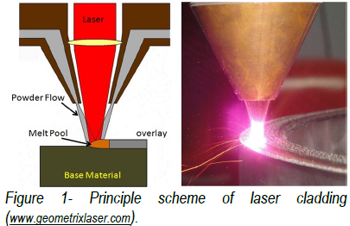 At the same time and location, the laser is irradiated. As a result, a molten pool forms on the surface of the substrate. By moving the powder nozzle and the laser beam, the molten pool moves on the surface and finally, a bead is created on the surface (Figure 1). Printing the material layer by layer leads to additively manufacturing the part. This process is called laser-powder direct energy deposition (L-DED). During these processes, behind the molten pool, where solidification occurs, the microstructure of the material is formed by crystallization. On the other hand, the different shapes of the molten pool represent different temperature profiles. Each temperature profile results in a unique microstructure. In order to produce a part with strong and isotropic mechanical properties, it is necessary that its microstructure contains fine and sphere-shaped grains (not elongated in a certain direction) (Figure 2). For this purpose, it is necessary that the cooling rate in the process is maximum and the temperature gradient is minimum.
At the same time and location, the laser is irradiated. As a result, a molten pool forms on the surface of the substrate. By moving the powder nozzle and the laser beam, the molten pool moves on the surface and finally, a bead is created on the surface (Figure 1). Printing the material layer by layer leads to additively manufacturing the part. This process is called laser-powder direct energy deposition (L-DED). During these processes, behind the molten pool, where solidification occurs, the microstructure of the material is formed by crystallization. On the other hand, the different shapes of the molten pool represent different temperature profiles. Each temperature profile results in a unique microstructure. In order to produce a part with strong and isotropic mechanical properties, it is necessary that its microstructure contains fine and sphere-shaped grains (not elongated in a certain direction) (Figure 2). For this purpose, it is necessary that the cooling rate in the process is maximum and the temperature gradient is minimum. 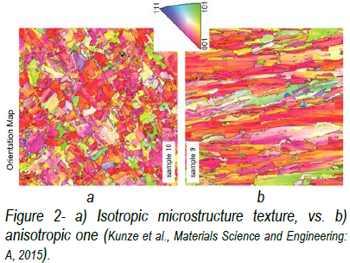 By optimizing the laser beam shape and power distribution (laser beam intensity profile), the temperature profile can be optimized to achieve the desired microstructure.
By optimizing the laser beam shape and power distribution (laser beam intensity profile), the temperature profile can be optimized to achieve the desired microstructure.
Examples of different laser beam intensity profiles are shown in Figure 3.
Assignment
Finding the optimal laser beam intensity profile through simulation, to achieve a temperature profile with the highest possible cooling rate and lowest possible temperature gradient in the laser cladding as well as laser-powder based direct energy deposition additive manufacturing processes.
Tasks (preliminary)
1. Literature review 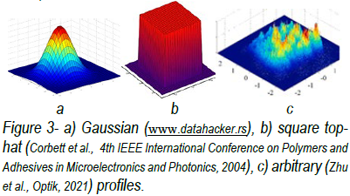
2. Development/use of a thermal model to calculate the temperature profile as a result of the heat source (laser), without considering the phenomenon of melting in laser melting, laser cladding, and laser additive manufacturing.
3. Comparison of temperature profiles as a result of different laser beam intensity profiles.
4. Investigate the importance of all parameters that need to be optimized to achieve a suitable microstructure.
5. Finding the best laser beam intensity profile to optimize the temperature profile, using the thermal model in task 2 and the stochastical modeling methods.
6. Investigation of the effect of optimized beam intensity profile on temperature profile using an in-house advanced thermo-fluid model.
7. Writing MSc thesis.
8. Co-authoring a paper (if relevant).
Reporting is an ongoing task in this MSc-project.
Start & duration
Start: As soon as possible
Duration: About 9 months (40 EC)
Supervisor(s)
• Prof.dr.ir. Gert-Willem Römer, g.r.b.e.romer@utwente.nl
• Dr. Martin Luckabauer, m.luckabauer@utwente.nl
• Mohammad Sattari, m.sattari@utwente.nl, daily supervisor
Printing of graphene for photonic devices
In the last decade, graphene has shown a multitude of uses in electronics, mechanics or photonics. The material shows high strength,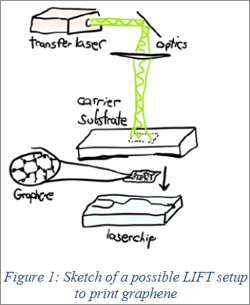 has (semi-) conducting properties, interacts with light and is very thin. This makes it interesting for many devices. The fabrication of precision devices with graphene relies still a lot on manual processes which might introduce defects and chemical impurities causing degradation of the physical properties. The project aims at looking at a laser-assisted process, known as laser-induced forward transfer (LIFT), to print a single or multiple layer(s) of graphene onto a target substrate in an intact state. In such a way we hope to increase the reliability of transfer and reduce contamination. Both factors contribute to maintaining the desired properties of the graphene material. To prove the concept that transfer via a laser-based method is feasible, we are aiming at fabricating a photonic device, namely a saturable absorber for an integrated mode-locked laser.
has (semi-) conducting properties, interacts with light and is very thin. This makes it interesting for many devices. The fabrication of precision devices with graphene relies still a lot on manual processes which might introduce defects and chemical impurities causing degradation of the physical properties. The project aims at looking at a laser-assisted process, known as laser-induced forward transfer (LIFT), to print a single or multiple layer(s) of graphene onto a target substrate in an intact state. In such a way we hope to increase the reliability of transfer and reduce contamination. Both factors contribute to maintaining the desired properties of the graphene material. To prove the concept that transfer via a laser-based method is feasible, we are aiming at fabricating a photonic device, namely a saturable absorber for an integrated mode-locked laser.
The main goal of this assignment is to establish a laser-assisted method to mechanically transfer a microscopic area of graphene onto an optical chip substrate.
Modeling and simulation of laser material interaction for bulk sapphire
Sapphire, also known as single crystal aluminum oxide, alpha-alumina or simply alumina is a single crystal form of the mineral corundum. Its unique properties make it a first choice for many high performance applications. When exposed to femto- or pico-second pulsed laser radiation, this chemically inert crystalline material is amorphized and the irradiated material can subsequently be selectively etched. This technique allows the fabrication of structures in/below the surface of sapphire substrates, for example, micro/nano-sized features (on sapphire surfaces), or embedded microfluidic networks (inside the bulk of sapphire substrates).

The more efficient and cost-effective method to predict the outcome of the laser-material interaction during the formation of subsurface modifications in crystalline sapphire is to simulate this behavior through a numerical model. The objective of this MSc. thesis is to develop a model for laser material interaction inside the bulk of a sapphire substrate. The primary goal of the model is the selection of suitable laser processing conditions for the modification of sapphire. For the purpose of validating the model, a secondary goal is to obtain a reasonable match between the results of modeling with experimental outcomes.
Design of surface textures and laser implantation of the textures
Surface roughness is widely applied to sheet metal strips to improve (amongst others) formability, optical appearance and paint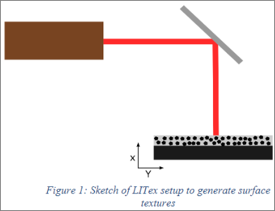 adherence. The desired strip surface roughness characteristics are achieved during temper mill rolling, where roughness from the rolls is are partially transferred to the strip under high contact pressures, and rolling speeds. Currently, mainly stochastic surface structures are applied to the temper mill roll, resulting in stochastic surface roughness on the steel strip. However, developments in laser texturing, electronic beam texturing and laser implantation allow for more freedom in surface design –for example, the production of (pseudo-)deterministic surface textures. Such freedom in surface texturing can open up a new possibility of surface structures and thus sheet metal properties.
adherence. The desired strip surface roughness characteristics are achieved during temper mill rolling, where roughness from the rolls is are partially transferred to the strip under high contact pressures, and rolling speeds. Currently, mainly stochastic surface structures are applied to the temper mill roll, resulting in stochastic surface roughness on the steel strip. However, developments in laser texturing, electronic beam texturing and laser implantation allow for more freedom in surface design –for example, the production of (pseudo-)deterministic surface textures. Such freedom in surface texturing can open up a new possibility of surface structures and thus sheet metal properties.
This assignment focuses on the design of deterministic surface structures, production using Laser Implantation TeXturing (LITeX, figure 1), and the analysis of the produced surface structures. Which shapes or patterns are desired? After a literature review, a selection of patterns will be chosen and produced (using LiTeX). After production, the roughness and tribology properties should be studied and identified.
